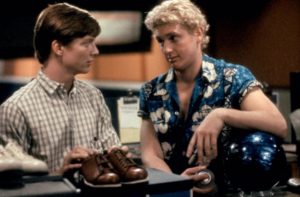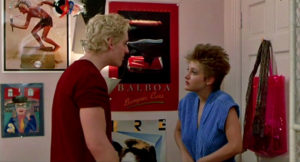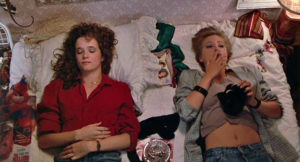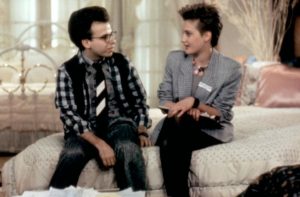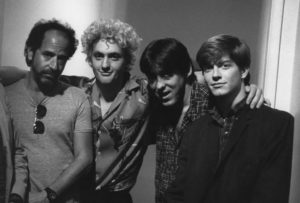The Wild Life – Production Notes
Throughout their childhood, teenagers are often told about the promised land that awaits them… “once you’ve finished high school.” Bill Conrad (Eric Stoltz) is a young man who’s graduated and is ready to begin his life as an 18-year-old single adult. What awaits Bill and the friends around him is “The Wild Life.”
Writer Cameron Crowe, who introduced the humor and struggles of contemporary teenagers in “Fast Times at Ridgemont High,” now gives us a hilarious ‘suburban epic’ that examines the precarious move from high school and life at home to adult living in “The Wild Life.”
An Art Linson Production, “The Wild Life” stars Christopher Penn, Lea Thompson, Eric Stoltz, Jenny Wright, Ilan Mitchell-Smith, Rock Moranis, Hart Bochner and Randy Quaid as Charlie. The Universal Picture is directed by Art Linson, produced by Art Linson and Cameron Crowe and written by Cameron Crowe. The original musical score is by Edward Van Halen and Donn Landee. C.O. Erickson is the executive producer and Don Phillips is the co-producer.
With “The Wild Life,” Linson and Crowe follow Bill Conrad from the security of a room at home to a singles apartment complex and a new life in the “real world” of adults. At first, it’s a disaster. Taken by a bad contract on his first apartment lease, Bill runs out of money. To stay in his apartment, he must enlist the help of his partner from work, the only person available, notorious party animal Tom Drake (Christopher Penn). The coupling affects those around him from his girlfriend to his parents. Set against the backdrop of the last week of summer, “The Wild Life” is about making the tentative step towards adulthood.
“Everyone changes in the course of the movie and we forget that some of these teenagers ultimately have to go back to school and make that work,” says Crowe. “We’ve tried to make it more than just another hi-jinks movie.”
“‘The Wild Life’ is about real kids who face real life situations for the first time,” adds Linson. “They find that it’s not easy growing up, but it can be funny and compelling.”
The story follows five young people through their lives at the end of summer. Two girls outgrow their boyfriends and venture forth into the world of older men. One boy develops a friendship with a Vietnam Vet that will change him. The film ends when they must all go back to school. It’s the first time, after seeing the full and dynamic lives that all five characters lead, that we realize they are still teenagers.
All the characters have their own themes. These young people struggle with new-found responsibility, independence, money and sexuality while trying to find the path that will lead them to the next step in their lives. What they discover is that just being older doesn’t make things easier.
“‘The Wild Life’ is about normal kids,” states Crowe, “and the small moments in their lives are, of course, monumental to them. After seeing thousands of movies and television shows about leaving home and achieving true independence, most young people feel they are ready to leave long before they actually are ready. When they do, it’s a painful and often humorous readjustment period.”
The filming of “The Wild Life” took place in several locations in and around Los Angeles and the San Fernando Valley. Director/producer Art Linson and writer/producer Cameron Crowe strived to find locales not only indigenous to suburban life but also unique to moviegoers. The look of the film had to be as original as the story it was telling.
The first step for Linson and production designer Bill Sandell was creating the mythical suburb of Alexander. They wanted to convey an atmosphere of suburbia on the edge of a megalopolis. They scouted locations in the Southern California area that were appropriate while keeping in mind that every physical aspect had to be perfectly suited for the characters and the action.
In Torrance, California, they came across the ideal site for Alexander High School. They persuaded the administration of Torrance High School to allow them use of the grounds. To make things easier for this shoot, filming was done during spring break. This allowed everyone the opportunity to move about without imposing restrictions. The exterior shooting took five days. The one interior shot, the film’s opening sequence where Jim Conrad makes a guerrilla assault on the school, was shot in one night.
One of the more ambitious undertakings was turning the ladies’ lingerie department in the Broadway department store into the “Fashion Dynasty,” the hip department store for upwardly-mobile teens. Production designer Sandell constructed his own store within a store. They even supplied their own merchandise and mannequins. Because filming took place during the business hours of the Broadway, the filmmakers had to insure that the production would not be an obstruction. With the cooperation of the Broadway, they were able to create a sense of flow by regulating the store’s escalators. One of the more interesting experiences during this shoot was when there was a blackout throughout the store and everyone had to remain on their marks to insure the scene’s continuity.
One of “The Wild Life’s” principal locations is Parker’s Bowl, where Tom Drake and Bill Conrad work. Because Linson wanted to maintain this feeling of authenticity, it was agreed that they would use an actual bowling alley instead of building a set. In Burbank, they found the ideal place to shoot these scenes, a vintage bowling alley called Marlindo’s Bowl. In order to have its own personality, crews designed their own signs and neon lights for Parker’s Bowl. Again, filming was done during business hours, but extras were used instead of the usual crowd that frequented Marlindo’s Bowl.
Another location in “The Wild Life” where an actual locale was needed instead of a set was for Doughnut City. Linson and Sandell wanted to create an environment for cinematographer Jim Glennon that felt like it was part of a franchise. In Torrance, California, they found the perfect doughnut store, Rolling Doughnuts. With the cooperation of the owners and the city of Torrance, they were able to use this location for some difficult shooting, including a car blowing up in front of the store.
The other principal location was the setting for the singles complex where Bill Conrad and Tom Drake settle. This proved to be an endless task, but after scouting the hundreds of complexes in the Los Angeles area they came to the Club Equestrian in the San Fernando Valley. Not only did the apartment project evoke a sense of the swinging single that seemed perfect for The Club Horizon, but the cooperation of the management of the Club Equestrian and the tenants also made what could have been a difficult shoot a real pleasure.
As for the interior of Bill and Tom’s apartment, this was just one of the sets that were constructed on Universal’s Stages 20 and 36. The other sets included Eileen Phillips’s bedroom, Jim Conrad’s room that included a treasure trove of Vietnam War Paraphernalia and Charlie’s house, Jim Conrad’s personal link to his romantic visions of the Vietnam War.
The numerous exterior shots used for the homes of Eileen Phillips, Bill and Jim Conrad, Anita Thompson and Tom Drake were shot in the Burbank and Studio City area. Some of the street scenes were shot in Huntington Park.
Both Linson and Crowe feel that the music is central to the story of “The Wild Life.” The music is the ambiance of the film and is used to the greatest advantage throughout the film. It is a combination of what these kids listen to today.
Edward Van Halen, lead guitarist of Van Halen, and Donn Landee are scoring the music for “The Wild Life.”
“Because Edward Van Halen as part of Van Halen already creates the soundtracks to many kids lives, we always had him in mind to score this film,” says Crowe.
“The Wild Life” is the first feature film Van Halen has scored.
Donn Landee has been a long-time partner, engineer and arranger of Edward Van Halen’s music since the first Van Halen album in 1976. He and Van Halen operate 5151 Studios, where “The Wild Life” soundtrack music was composed and recorded. Landee’s previous credits include engineering albums by Neil Young, Van Morrison and The Animals.
About The Cast
Tom Drake (CHRISTOPHER PENN) is the 17-year-old self-appointed “love-God” of Alexander High. He races through life as if were an Elvis Presley movie. Drake, who works at Parker’s Bowl, is that unique type of person who is somehow much more confident than he has any reason to be. A wrestling champ and party connoisseur, Drake is the only person Bill Conrad can turn to in order to stay in his new apartment.
Penn most recently appeared as Willard, the hayseed who learns to dance, in Herbert Ross’ “Footloose.” Prior to that, Penn was seen in “All the Right Moves” and he worked for director Francis Ford Coppola in “Rumble Fish.”
Penn also wrote, produced, directed and co-starred in “Nobody’s Heroes,” his own film about the Vietnam War, when he was 16.
Bill Conrad (ERIC STOLTZ) is in training to be a young American consumer. He watches MTV, believes what he reads, listens to the radio and is ready for someone to proclaim him “An Adult!” Finally, he gets his own apartment. “I know I wasn’t the most exciting guy in high school,” he tells Tom, “But I have a feeling this experience is going to change me. I’m in the ‘Real World’ now.” It does change Bill and he becomes the catalyst around whom all the characters revolve.
Stoltz most recently finished work on “Next of Kin” and “Lucky 13” is due out for release later this year. Stoltz also appeared in “Fast Times at Ridgemont High.”
Stoltz, a former drama student at USC, has appeared on stage in productions of “Our Town,” “Jesus Christ Superstar” and “Tommy.”
Stoltz recently filmed Universal’s “Mask,” co-starring with Cher.
Anita Thompson (LEA THOMPSON) is a 17-year-old girl on the rebound from Bill Conrad. She has a job and seeks her independence through a new and exciting boyfriend. She is barely prepared for what happens.
Thompson made her screen debut in a low-budget independent film and then landed a key role in Universal’s “Jaws 3-D.” Her performance with Tom Cruise in last year’s “All the Right Moves” won her much praise. Most recently, Thompson starred in John Milius’ “Red Dawn,” which was released this summer.
Eileen Phillips (JENNY WRIGHT) is the 17-year-old upwardly mobile girlfriend of Tom Drake. She works at Fashion Dynasty, the young fashion section at a large department store. She is outgrowing her high school boyfriend and it’s not easy for here.
Wright has appeared in Pink Floyd’s “The Wall” and “The World According to Garp.”
She had a featured role in the Broadway production of “Plenty,” starring Kate Nelligan, and appeared in “The Executioner’s Song”.
Jim Conrad (ILAN MITCHELL-SMITH) is Bill’s 15-year-old younger brother. He is an intriguing character, not unlike one of the many kinds running around in Army fatigues and camouflage pants today. Jim grew up in the ‘;70s and everything he has been taught led him to believe that the ’60s were the most exciting time imaginable…and he missed it. Jim listens only to ’60s music, his favorite movie is “Apocalypse Now” and his heroes are all products of his romanticized notion of the ’60s. He can barely be bothered that his brother is leaving home. His hero is a Vietnam Vet.
Mitchell-Smith played the role of young Daniel in Sidney Lumet’s “Daniel.” He also played the lead role in the PBS production of “How to Be a Perfect Person in Three Days.” He received a scholarship to the Joffrey Ballet and is a member of The Pioneer Ballet Company.
Harry (RICK MORANIS) is Eileen’s co-worker at Fashion Dynasty. His dress and lifestyle, everything but his personality, is uniquely GQ. He’d like to get something going with Eileen.
Moranis has most recently been seen in Ivan Reitman’s “Ghostbusters,” with Dan Aykroyd, Bill Murray and Sigourney Weaver. He is also featured in Walter Hill’s “Streets of Fire.” He directed and starred in “Strange Brew.”
Moranis, one of the original stars of SCTV, was half of “Bob and Doug McKenzie,” whose album “The Great White North” received a Grammy nomination. The album also reached Gold.
David Curtis (HART BOCHNER) is the mysterious new boyfriend who captures Anita’s attention. Bochner made his screen debut in “Islands in the Stream.” He was also a featured player in Peter Yates’ “Breaking Away” and co-starred in George Cukor’s “Rich and Famous.” Later this year, he will be seen in the NBC mini-series “The Sun Also Rises,” co-starring with Jane Seymour.
Bochner made his television debut in the telefilm, “Haywire.”
Mr. Parker (JACK KEHOE) is the harried owner of Parker’s Bowl. A former bowling champ, now he’s the boss of Tom Drake and Bill Conrad.
Kehoe has been seen in such films as “The Star Chamber,” “Reds,” “Melvin and Howard,” “Car Wash,” “Serpico,” “Godfather I,” “The Sting,” “The Friends of Eddie Coyle,” “The Gang That Couldn’t Shoot Straight” and “Panic in Needle Park.”
He has also been seen in the telefilm, “The Ballad of the Sad Cafe,” and “The Basic Training of Pavlo Hummel.”
Charlie (RANDY QUAID) is the Vietnam Vet whom Jim Conrad idolizes. He is Jim’s symbol of manhood and of everything he perceives the ’60s to be about.
Quaid was most recently seen in the heralded off-Broadway production of Sam Shepard’s “True West,” co-starring with his brother Dennis Quaid.
Quaid has had some memorable roles in films such as “National Lampoon’s Vacation,” “Breakout,” “Bound for Glory,” “The Missouri Breaks,” “The Choir Boys,” “The Long Riders” and “Foxes.”
On television, he has been seen in “A Streetcar Named Desire,” “Cowboy,” “Inside the Third Reich,” “Of Mice and Mean,” “Mad Messiah,” “To Race the Wind,” “Raid on Coffeyville” and “Niagra.”
Craig Davis (ROBERT RIDGELY) is the manager of Club Horizon, the “swinging singles” apartment complex where Tom Drake and Bill Conrad take an apartment together.
Ridgely has had featured parts in such films as “Melvin and Howard,” “High Anxiety,” “Blazing Saddles” and “History of the World, Part One.”
Ridgely has appeared in numerous episodic television programs. He was recently seen in the Universal television series, “Domestic Life,” which starred Martin Mull. He co-starred with Christopher Walken and Susan Sarandon in the PBS American Playhouse production of “Who Am I This Time?”
Ridgely’s voice has been used in cartoons for “Flash Gordon” and “Tarzan.”
Tony (BRIN BERLINER) is the good friend of Jim Conrad, who is also fascinated with everything related to the ’60s.
“The Wild Life” is Berliner’s feature film debut. He spent one year as an apprentice at Zoetrope Studios Student Workshop. Berliner is 14-years-old.
Benny (ANGEL SALAZAR) is one of Tom Drake’s wrestling buddies in “The Wild Life.”
Most recently, Salazar appeared as ChiChi in “Scarface.” Prior to that, he appeared in “Boulevard Nights,” “A Stranger is Watching,” “Walk Proud,” and “Where the Buffalo Roam.”
On stage, he appeared in Los Angeles with Bill Bixby in the original production of “Steambath” and also appeared on stage in “Savages,” “American Buffalo” and “P.S., Your Cat is Dead.”
In addition to his career as an actor, Salazar has extensive experience as a stand-up comedian, having appeared regularly at Catch a Rising Star, The Comedy Store and The Improv.
Vince (MICHAEL BOWEN) is another close friend of Tom Drake’s in “The Wild Life.”
Bowen has appeared in several films, including “The Check is in the Mail,” “On the Line,” “Valley Girl,” “Mata Hari,” “Forbidden World” and “Silent Speed.”
On television, he has appeared in “Days of Our Lives,” “The Fall Guy,” “Knott’s Landing,” “Chips” and “Falcon Crest.”
His extensive stage background includes appearances in productions of “A Streetcar Named Desire,” “Hatful of Rain,” “Lovers and Other Strangers” and “Knockout.”
About The Filmmakers
CAMERON CROWE began his professional writing career at the age of 15. He spent eight years as a journalist for Rolling Stone and other publications prior to writing his first book, “Fast Times at Ridgemont High,” for Simon and Schuster. His debut as a screenwriter came from his own adaptation of the book. “The Wild Life” is Crowe’s first original screenplay, which he also produces.
“What I like to do is write about real life,” says Crowe. “‘The Wild Life’ is based on real people, but it’s not an elaborate set-up. The original idea came from my fascination with watching kids, 10 years after the Vietnam War, walking around in military fatigues and listening to ’60s music. I kept wondering what their appearances and attitudes meant to them, since they were too young to have experienced the war. I had met Chris Penn at a time when he was deeply into this phase and I wanted to write about a guy like Chris.”
Ultimately, Crowe was unable to find anyone who was as colorful as Christopher Penn, so he decided to interview Penn in an effort to understand the mentality. “We did an interview at the top of the Beverley Center in Los Angeles. Chris walked in an hour late in fatigues, with Jimi Hendrix music blaring from his tape machine. The interview with Chris helped me to formulate what is now ‘The Wild Life,'” says Crowe. “Chris really helped me to nail down the mentality of a 16-year-old dreaming about Vietnam. I wanted the character in ‘The Wild Life’ to come face-to-face with what he was really idolizing.” (In “The Wild Life,” this character becomes Jim Conrad, played by Ilan Mitchell-Smith.)
“In ‘Fast Times at Ridgemont High,’ I was writing about real people. This limited what I could do with the characters, unlike ‘The Wild Life,’ which allowed me to make more choices with the material. ‘The Wild Life’ is a more cohesive work than ‘Fast Times at Ridgemont High,’ which was a collection of experiences,” adds Crowe.
“Both ‘The Wild Life’ and ‘Fast Times’ deal with a similar theme: that it is not easy to be on your own. The difference is that ‘Fast Times’ dealt with high school kids and ‘The Wild Life’ deals with other people who are still finding out that it’s not easy,” remarks Crowe.
“Art (Linson) and I stayed away from any type of sequel since there is a built-in disappointment factor when audiences go in wanting to see what they already loved. ‘The Wild Life’ is really the next step. No one in the film has much to do with high school — it has more to do with leaving home,” says Crowe. “‘The Wild Life’ still deals with a lot of experiences that are happening to the characters for the first time. This time, no one is a virgin,” adds Crowe. “To me, leaving home was a big step. Since it was a heavy time in my life, I wanted to write about it.”
“‘The Wild Life’ is also about the last week of summer. These young people reach the end of this period of time when you are supposed to have a really wild time and, as it get towards the end of the summer, they realize that they haven’t stockpiled enough experiences yet and decide to blow it out a bit more. The film is about these kids who blow it out a bit more and discover how hard it is getting it back to normal,” says Crowe.
“We really try to avoid a stitch plot…we try to be authentic and to have the story come from authenticity,” Crowe continues. “Everyone changes and we, of course, forget that they are teenagers because their lives have changed so much by the end of the summer; you forget that they are going back to school.”
“The Wild Life: is the second film that Crowe and Art Linson have made together. They plan to start production on a third feature, “Singles,” this Fall, about the rituals of dating during the mid-20s of your life. The film will be set in Phoenix. “This is the third in a series of films that Art and I wanted to do and which, for me, brings me face-to-face with my own age group. This is very exciting because I can write about the kinds of things that are happening to me now. It’s not like research. It’s very personal. The films Art and I have done together are real-life comedies.”
Linson and Crowe fist got together when Thom Mount at Universal gave the galleys of “Fast Times at Ridgemont High” to Linson, whom he felt would have the right feeling for the material. “Art liked the Spicoli character and I began to pin down the screenplay,” adds Crowe.
Born in Palm Springs, California, Crowe is currently completing the screenplay for “Singles” and is writing a biography of Neil Young. He recently co-directed the MTV Sunday Special “Heartbreaker Beach Party,” a profile of Tom Petty and the Heartbreakers.
ART LINSON is a filmmaker whose movies have captured the spirit and music of their times. He has produced a string of successful films, including “Fast Times at Ridgemont High,” “Melvin and Howard” (the winner of two Academy Awards), “Car Wash,” “American Hot Wax” which he co-wrote, and “Rafferty and the Gold Dust Twins,” which have all depicted slices of America through his non-traditional approach to film.
Linson made his directorial debut with “Where the Buffalo Roam,” starring Bill Murray, which he also produced. The film has now become standard midnight fare as a cult classic.
For his current film, Linson directs and produces “The Wild Life” because he finds material about young people to be very appealing.
“‘The Wild Life’ is about real kids who face real life situations for the first time,” adds Linson. “They find that it’s not easy growing up, but it can be funny and compelling.”
“The Wild Life” is the second of three films that Art Linson and Cameron Crowe will make together for Universal. Their third film, “Singles,” which Linson will direct from a screenplay by Crowe, depicts dating rituals of people in their mid 20s. Production is expected to begin in the Fall of 1984.
Courtesy of Universal Pictures


